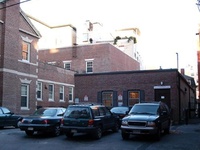“It’s very difficult...to keep those satellite areas feeling like they’re part of the school,” he says.
But many professors worry about moving their campus to a location that is currently little more than an industrial wasteland.
“There’s no amenities there—it’s not a pleasant place,” Laird says. “That’s one of the worst features about it, is that it’s really not a nice location they’re putting us in.”
University officials have long maintained that by the time facilities relocate to Allston, the neighborhood will have been redeveloped into a bustling cultural nexus, as exciting and appealing as Harvard Square.
But some professors aren’t hearing the central administration on this point. In fact, some professors say the central administration isn’t hearing them, either.
“The thing that was most disheartening is that Larry Summers sort of announced [an SPH move in his letter] as if it were a fait accompli, before people at the School of Public Health knew it,” Laird says.
Concerns about Allston go beyond location and process to get at important programmatic questions.
For a school whose mission has always been inextricably entwined with HMS, a move to Allston—three miles removed from HMS and the rest of Longwood—touches on fundamental questions about the future of the field of public health and SPH’s role in it.
While Summers and other Allston proponents trumpet the virtue of increased SPH collaboration with Cambridge schools like the Faculty of Arts and Sciences (FAS) and the Kennedy School of Government (KSG), many professors worry that geographic separation from the school’s heart in Longwood may set SPH adrift academically.
A substantial number of SPH faculty split time at HMS, affiliated hospitals and research centers. If the school does move, effective mass transportation between Allston and Longwood—which is now virtually nonexistent—must be created, as 62 percent of faculty said they would need to commute back to Longwood at least once a week, according to the report.
Solutions still remain elusive.
The report mentions a possible rail link from Allston to Boston University, where busses would then transport passengers to Longwood. This is the backbone of a possible, even if unlikely, option.
With the proliferation of e-mail and the widespread use of conference calls, however, some doubt that distance is really significant. Sixty-three percent of SPH professors agreed they “believed that enhanced conferencing and communication capabilities will reduce the need for face-to-face meetings,” according to the report.
“Distance is an artificial argument,” says Grace Wyshak, associate professor of biostatistics and population and international health.
“I don’t see [a move] as severing ties from the medical school, and, to be honest, I don’t see them more than a few times per year,” Shore says.
Read more in News
Black Female Alums Celebrate Third Decade














